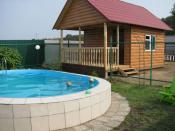Search
Login
Recommended
DIY bath roof
The bath is a source of health and longevity, it gives true pleasure to the body and gives a great mood. In order for the bathhouse to fulfill its basic functions and last for many years, the correct construction of each of the elements of this building is necessary.
During the construction of the bath, it is important to pay attention to each stage of its construction, the totality of all correctly performed works guarantees the durability of the building, therefore, to ensure the success of the proper construction, you need to know how to properly make the roof of the bath.
Content
- General information
- How to make a pent roof
- Gable roof
- Laying of a roof, waterproofing and heat-insulating materials video video
General information
What the roof will be depends on many factors, including the area of \u200b\u200bthe building, the material from which the walls were built, and the nature of the area where the bathhouse was built.
Before you start building the roof of the bath, you need to choose what design it will be.
Roof structures are:
-
with the attic;
-
without an attic.

The roof of the sauna with your own hands with an attic is optimal for a bathhouse that will be used in the winter. Such roofs are characterized by high thermal insulation properties, and heat transfer through the ceiling is usually minimal. In addition, the attic can serve as a relaxation room, a billiard room or a place to store bath accessories.
In summer baths, it is better to erect unhappy roofs.

Now you need to choose a roof in shape. They are divided into 2 types:
-
single slope;
-
gable.
How to make a single-type sauna roof

This type of roof is the simplest, respectively, requires the least time and money. A pitched roof is suitable for small baths, as well as for those baths that are erected as an extension to another building. Centaur motoblocks will be great helpers in transporting building materials in small batches, if you have a trailer truck.
It is preferable to build a building with a similar roof in places where there is a large wind load, this will reduce the overall windage of the building.
It is worth noting that snow and rain from the pitched roof slide worse than from the pitched roof, which gives it an additional load.

In order to prevent rainfall from stagnating on the roof, a shed roof must be built at a certain angle. The most optimal slope is 20-30˚, in areas with heavy rainfall it is recommended to build a roof with a slope of 45˚. It is worth considering that the consumption of materials in this case will be greater, but the bath will be protected from possible serious damage to the roof.
roof construction steps

-
Mauralat installation (guide beams). Beams are attached to the wall of the building with anchor bolts.
-
Preparation of rafters. To begin with, nests for rafters are cut down, then the rafters are attached with slate nails to the Mauerlat. Rafters should be installed at a distance of 60-80 cm, and protrude beyond the walls 15-30 cm.
-
Crate. The crate, after a certain distance, depending on the type of roof, is nailed perpendicular to the rafters.
-
Laying waterproofing and roofing. The selected waterproofing material is laid on the crate, and then, the roofing material.
Gable roof

A gable roof provides a good slope to precipitation, which positively affects its life. In addition, such roofs allow the arrangement of an attic. It is worth considering that the cost of such a roof is higher than a shed.

we build a roof of a bathhouse of a gable type


-
The construction of the attic floor. The assembly of the roof begins with the erection of the attic floor, which can be assembled on the ground, and then raised to the roof.
-
Install Mauerlat. It is installed on the finished walls, if the walls of the bath are built of a gas block, foam block, brick, the surface before installation must be insulated using a special surfaced material. For a uniform load, the logs for the Mauerlat should be at least 18 cm. Accordingly, with the laying of the Mauerlat, the location of the rafters and the nests for their installation are determined.
-
Installation of rafters. Rafters can be assembled on the ground, or directly during installation. The rafters should be installed every 60 cm. 1.2 m, after which they are connected with iron brackets to the Mauerlat. For the cornice, it is necessary that the ends of the rafters protrude up to 30 cm above the wall.
-
Crate. Depending on the type of coating, the crate can be either solid if roofing material is selected, or located at a certain distance (up to 1 m.) If slate is selected.
-
Waterproofing.The waterproofing material is attached with a stapler to the rafters.
-
Thermal insulation.How the roof will be insulated and what material will be used depends on whether there is an attic in the bathhouse and whether it will be used as a living room, but under any condition the insulation should be non-combustible. The most commonly used materials are mineral wool, ecowool, stone wool, etc.
-
Installation of the roof. After laying the waterproofing and thermal insulation, the roofing material must be laid.

In order to know how to build a bathhouse roof, it is necessary not only to know the main phases of construction, but also to know how a roofing and waterproofing material is selected and mounted.
Laying of a roof, waterproofing and heat-insulating materials

As roofing material for the bath, roofing material, slate, metal tile, corrugated board and galvanized sheet can be used.

The roofing material is the cheapest, but its service life is much lower than other materials.
Laying of roofing material should be made with an allowance of 10-15 cm., At the same time, care must be taken so that waves do not form. Next, marks are made on the edges of the material protruding beyond the borders of the crate, and cut them off.
The first sheet is strengthened with the help of special buttons, each subsequent laying of roofing material should be made with an overlap of 8-10 cm.
Skates are either bought ready-made at a store or made independently.
Roof waterproofing is carried out at the last stage of its construction. The most commonly used membrane film. It is laid directly on the rafters before installing the crate. The film should be laid with an overlap without a tie and fixed with tape.
Thermal insulation of the roof can be done in three ways: between the rafters, under them or laid on top of the rafters. It is most difficult to conduct thermal insulation between the rafters, but if you use three methods at the same time, you need to consider that such thermal insulation should be done closely, without gaps.

It should be noted that laying heat-insulating material under the rafters reduces the attic area, so it is better to lay the insulation on the rafters.
Thus, knowing how to build a roof on the bath, as well as other components of the bath, you can be sure that the bath is guaranteed to become a real source of health and vitality for many years to come.





